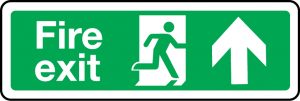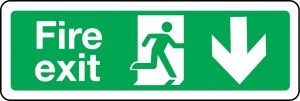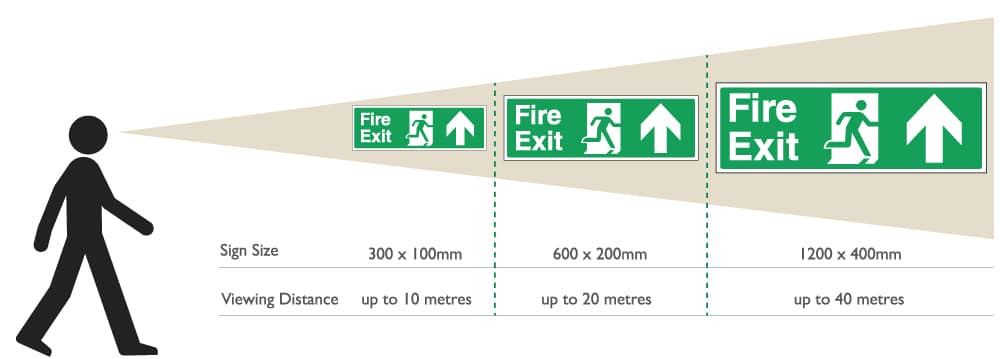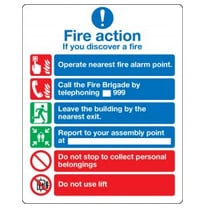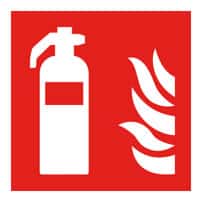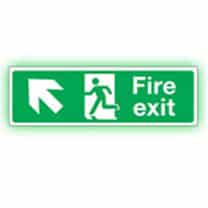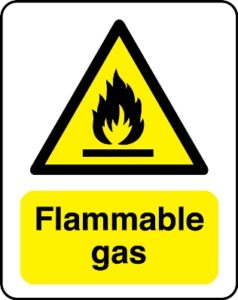Choosing your fire signage can be a daunting task. What exactly do you need? Where do you have to install them? Will you be compliant with BS EN ISO 7010? What happens if you get it wrong?
In the UK between 2010 and 2014, there were 97,500 fires in commercial premises, with 1,881 fatalities over the same period. It is essential to have clearly marked routes to exits and fire fighting equipment as this will help to limit the risk of loss of life.
Shop our Fire Signage Range now
Where do you place fire exit signs on the escape route?
The first step to determining your escape route is to find your primary escape route. This should be the shortest and quickest route out of the building from any given location. It is also essential to plan a secondary escape route, in the event of a fire makes the primary route impassable.
Determining the signage for your fire escape route is confusing, however, it can be simplified with a few simple guidelines;
- Within your building, an escape sign should always be visible
- Once past the first fire escape sign, the next escape sign along the route must be clearly seen
- Further signage is required at every change of direction along the escape route
- A fire exit sign must be above all final fire exit doors
- Ensure there are no conflicting signs along the route e.g. 2 arrow up signs back to back.
Fire Exit signs and where to use them?
Fire exit signs with left and right arrows:
Fire exit signs with left and right arrows are self-explanatory. If you see an arrow pointing to the left, what that is essentially saying is that you should “Progress to the left”. If you see an arrow pointing to the right, it is telling you that you should “Progress to the right”.
Where some of the confusion starts to come in around fire safety signs, is with the up and the down arrow.
Fire exit signs with up arrows:
Fire Exit Arrow Up is to be used when you have to continue along your route, towards another fire exit sign. It can also be used for final exits. The only exception to this is if there is a step-down or ramp immediately outside.
Fire exist signs with down arrows:
Fire Exit Arrow Down signs are to be used when you have to continue along your route, towards another fire exit sign. If after an exit sign there is a staircase leading down immediately after your sign, then a down arrow is required.
Are fire exit signs displayed on each fire exit door?
According to the UK Building Regulation requirements, an exit sign should be placed on every doorway, escape window or other routes which provides an exit to a fire.
What size fire exit sign do I need?
One of the most important things to consider when ordering a fire exit sign is the size. The size that you need is based on the maximum distance that the size needs to be viewed from.
Below is a guide to the sizes that you will need based on the distance in meters.
- 300mm x 100mm KD – Viewing distance up to 10 meters
- 450mm x 150mm NF – Viewing distance up to 15 meters
- 600mm x 200mm RG – Viewing distance up to 20 meters
- 1200mm x 400mm – Viewing distance up to 40 meters
- For illuminated signs the viewing distance doubles
When does photoluminescent help with fire signage?
Photoluminescent signs provide additional reliability. In the event of a power failure, they offer a constant source of illumination and invaluable guidance.
Fire safety sign regulations in the UK
All business premises need to have a minimum 2-3 fire safety signs. Training or having common sense is not acceptable for fire safety if an emergency were to occur. For example, if your premises frequently has visitors arrive, then it’s unlikely they’ll be sufficiently prepared if a fire breaks out, which is why visible signage is important for guiding people to safety.
If you’re responsible for commercial premises, you might already know that you need fire safety signs. But it can be tricky to work out which ones you need and where to put them.
There are two main pieces of fire safety legislation for fire safety signs:
The Regulatory Reform (Fire Safety) Order 2005
and
The Health and Safety (Safety Signs and Signals) Regulations 1996
The HSR describes the correct types, applications and maintenance of fire signage, and the RRFSO provides assessment guidance and precautions to deal with any risk.
The HSR states that the number of signs required and their positioning depends on the types of hazards or dangers on the premises.
The RRFSO instructs all businesses with premises to appoint a responsible person who can remain accountable for fire safety. One of the main duties is to undergo regular assessments to examine the business’s fire safety risks and hazards. Once these have been identified, the assessor must take action to ensure that risks are minimised, such as installing fire safety equipment, adding or replacing signage and even making changes to the layout of the premises to ensure it meets safety standards.
So what do you need? There are 4 main applications of fire safety signs in the UK:
-
- A ‘fire Action Notice’ explaining what to do in case of fire
- Safety signs marketing fire exit routes, doors, and assembly points
- Safety signs showing where fire-fighting equipment is located
- Warning and Prohibition signs such as ‘Danger’ or ‘No Smoking
What are the different types of fire safety procedure signs?
Type of sign
Meaning/Purpose
Requirements
Example
Fire Action Sign
A list of instructions to guide anyone inside a building if they discover a fire or need to evacuate the building.
All commercial premises must display a Fire Action Note. It’s recommended that you display this sign next to every fire alarm call point and at every final exit door.
Fire Equipment Signs
Information with an extinguisher ID to show people what the fire extinguisher is suitable for. These include: Class A fires: carbonaceous materials, Class B fires: flammable liquids, Class C fires: burning metals, electrical fires, Class F fires: cooking oils and fats.
Premises that keep fire fighting equipment must have adequate fire equipment signs in place near the equipment. There should be a fire extinguisher ID to show people what the fire extinguisher is suitable for.
Fire Exit and Door Signs
These signs guide people on evacuating a building safely and show which safety measures to take.
Non-domestic properties and multi-occupancy residential buildings are required to have fire exit and door signs.
Warning and Prohibition Signs
Warning signs let people know there is a fire risk nearby, prohibition signs display preventative actions to maximise fire safety.
You need a fire warning sign when flammable substances are on the premises, such as gas or oil. Prohibition signs are required when actions could a fire, such as smoking.
Making sure that you have these clearly marked out is key to making sure that your building is as safe as possible for everyone inside.
If you have a large complex project and require any additional information, our expert site survey team are happy to visit your premises to help.
Our sales team can be contacted on 01737 774072 for free advice, or alternatively, you can email.
